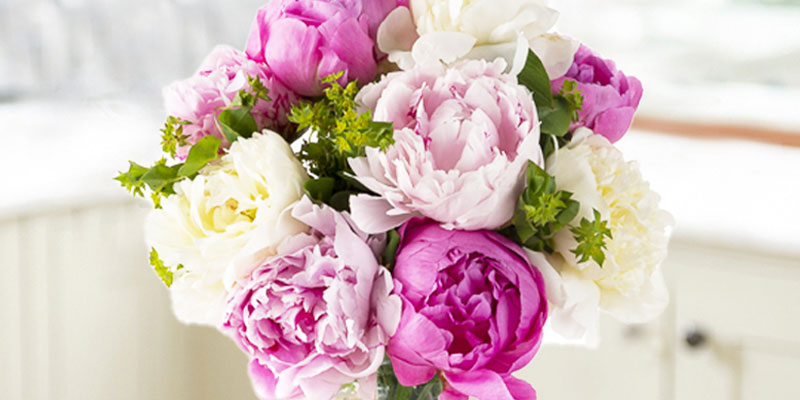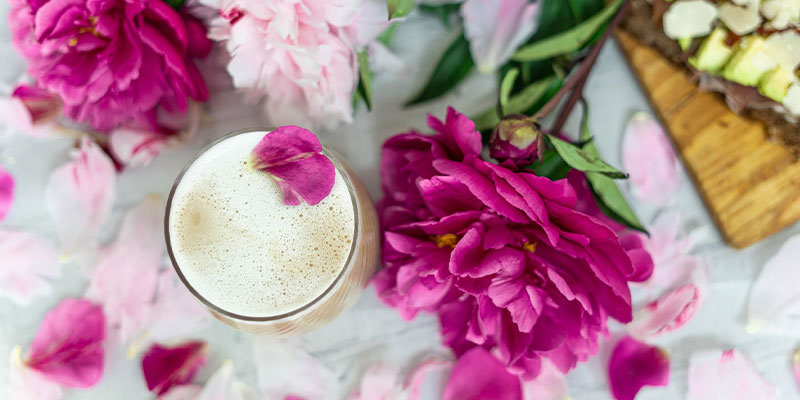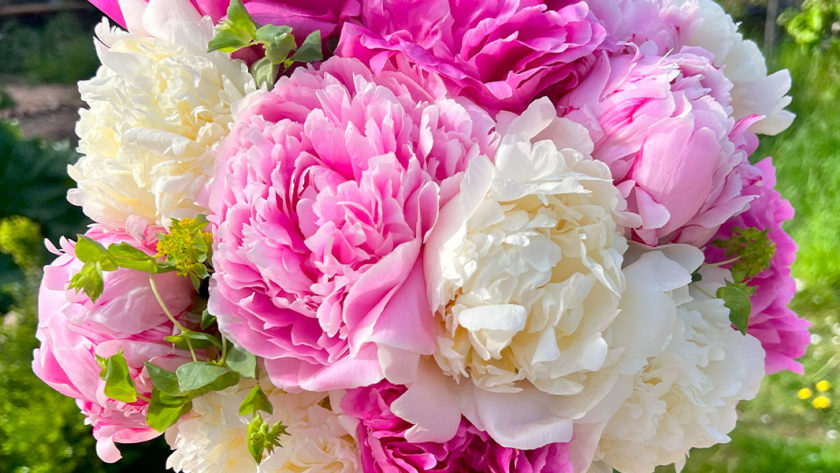Peonies are back in season, and we can’t get enough of them! Find out more about our summertime favourites in this article.
Everyone loves peonies, and it’s easy to see why – with their huge, cloud-like blooms and ruffled petals, they steal the show in any bouquet. Although they’re only around for a short time every year, they’re well worth the wait.
Want to know more about peonies? Keep reading for answers to all your questions about these beauties.
What do peonies symbolise?
Peonies have lots of lovely meanings, including romance, elegance, honour, fortune, and prosperity.
They’re also said to mark a happy marriage, so it’s no wonder they’re one of the most sought after wedding flowers, and also the twelfth anniversary flower.
In the Victorian language of flowers, they sent a message of bashfulness. It’s believed that this meaning came from the myth of Paeonia, a nymph who was turned into a flower by the goddess Aphrodite. The Victorians were also a bit superstitious about peonies, believing that dead or wilting peonies were a bad omen, whilst a plant full of flowers was a sign of good luck.
What colours do peonies come in?
Although pink peonies are the most recognisable and popular variety, they’re by no means the only type. Peonies come in a whole rainbow of colours, including white, red, maroon, coral, yellow, purple, and green. On top of that, there are multicoloured and two-toned varieties too – for example, the ‘Athena’ peony has pale pink flowers with a magenta centre.
The only colour you won’t find peonies in is blue. This is true for many other flowers as well; blue is a very rare colour in nature as plants can’t usually produce the pigment.

When are peonies in season?
If there’s one thing everyone can agree on, it’s that peony season is too short! Peonies are in season in the spring and summer, from around April to June.
What are the different types of peonies?
Not all peonies are the same. There are two main types – herbaceous peonies, and tree peonies. Herbaceous peonies are perennial bushes that die back into the ground in the winter, before re-emerging in the spring.
Tree peonies are shrubs with woody stems, and these stems stay above the ground throughout the year. They grow more slowly, but get taller and generally have larger flowers.
Within these two main types, there’s even more variation, with loads of different colours, flowers, and more. Although there are only 33 ‘official’ species of peonies, the full picture is a little more complicated, as most peonies grown today are hybrids. Altogether, there are around 6,500 varieties and cultivars of peony.
How big are peonies?
Fully grown, herbaceous peonies will be around three feet and tall and wide, whilst tree peonies can grow to around five feet tall.
Peonies also have truly impressive flowers. Herbaceous peonies can be up to 10 inches in diameter, whilst tree peonies can get even bigger, with some reaching 12 inches across. If you want even larger peonies, you can debud the stems so that there’s only one main bud on each stem. This helps the plant to focus its energy and produce huge, beautiful flowers.

Do peonies have health benefits?
In ancient times, peonies were believed to have a number of medicinal uses. In China, there are records of peonies being cultivated for medicine as far back as the sixth and seventh centuries, with the seeds and roots being used to treat blood stasis, high blood pressure, and inflammation.
In Ancient Greece and Rome, the roots were used to treat epilepsy and seizures, a practice which continued in Europe well into the Middle Ages. Recent studies have shown that this may actually have worked to some extent – peony roots contain chemical compounds that do have proven anticonvulsant properties.
Today, peonies are still used in skincare, as the root extract has excellent antioxidant and anti-inflammatory properties. It can help to make skin clearer, brighter, and firmer. White peony root is also used in herbal medicines to alleviate pain and swelling and improve blood flow.
Are peonies edible?
Peonies have been used in food for thousands of years. In Ancient China, they were used to flavour food, and the sweetened petals are still a popular delicacy today. The ancient Chinese philosopher Confucius is believed to have said he ate “nothing without its sauce”, because he loved the flavour of peonies so much.
The petals have a sweet, slightly fruity taste. If you want to sample them yourself there’s plenty of ways to try. Try sprinkling fresh petals over salads, or add them to cocktails and cakes for a floral garnish. With a little extra effort, you can even make jams and syrups.

How long do peonies live?
Peonies are a popular garden plant, and they live for a very long time. When looked after properly, they can live and bloom for up to 100 years. You’ll have to wait a little while at first though – they take around three years to start blooming after being planted. It’s definitely worth it for a lifetime of peonies though!
What do peonies smell like?
Peonies aren’t just beautiful – they smell amazing as well. The scent’s often described as being similar to roses, but sweeter. If you love the scent, make sure to choose the right peonies. Double peonies are usually more fragrant than single peonies, and pink and white flowers have a stronger scent than other colours. Red peonies often have very little scent at all.

Where are peonies from?
Peonies grow natively in cold and temperate areas of Asia, North America, and Europe. The Mediterranean has the most species of peonies, whilst North America has just two. They’re commonly found in woodland areas, but some types grow in the mountains.
This all means that peonies grow really well in the UK, as they’re fully hardy and used to colder temperatures. Simply plant them in your garden in a sunny spot with rich soil and plenty of space to create your own peony paradise.


